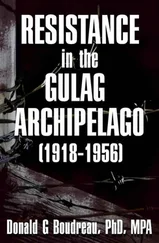And it is not necessarily August out; it might be December, 1946, and, there being no Black Maria, you are being herded at 40 degrees below zero to the Petropavlovsk Transit Prison. And it is easy to guess that during the last hours before arriving the Stolypin convoy refused to go to the trouble of taking you to the toilet, so as to avoid getting it dirty. Weakened from interrogation, gripped by the cold, you have a very hard time holding it—women especially. Well, and so what! It’s for horses to stand stock-still and loose the floodgates! It’s for dogs to go lift a leg against a fence. But as for people, you can do it right there, while you keep moving. No need to be shy in your own fatherland. It will dry at the transit prison…. Vera Korneyeva stooped down to adjust her shoe and fell one step behind, and the convoy immediately set the police dog on her and the dog bit her in the buttocks through all her winter clothing. Don’t fall behind! And an Uzbek fell down, and they beat him with their gunstocks and jackboots.
Well, that’s no tragedy: it won’t be photographed for the Daily Express. And the chief of convoy will live to a ripe old age and never be tried by anyone.
And the Black Marias, too, came down to us from history. In what respect does the prison carriage described by Balzac differ from a Black Maria? Only that the prison carriage was drawn along more slowly, and prisoners weren’t packed so tightly.
True, in the twenties columns of prisoners were still being driven afoot through our cities, even Leningrad. They brought traffic to a halt at intersections. (“So you got caught stealing?” came the reproaches from the sidewalks. No one had yet grasped the great plan for sewage disposal.)
But, always alert to technological trends, the Archipelago lost no time in adopting the black ravens, more familiarly known simply as ravens—Black Marias. These first Black Marias appeared at the same time as the very first trucks on our still cob-blestoned streets. Their suspension was poor, and it was very rough riding in them, but then the prisoners weren’t made of crystal either. On the other hand, they were very tightly corked even at that time, in 1927: there wasn’t one little crack; and there wasn’t one little electric light bulb, and there wasn’t any air to breathe, and it was impossible to see out. And even in those days they stood so tightly packed inside that there wasn’t any room left at all. And it wasn’t that all this was intentionally planned; there simply weren’t enough wheels to go around.
For many years the Black Marias were steel-gray and had, so to speak, prison written all over them. But in the biggest cities after the war they had second thoughts and decided to paint them bright colors and to write on the outside, “Bread” (the prisoners were the bread of construction), or “Meat” (it would have been more accurate to write “bones”), or even, simply, “Drink Soviet Champagne!”
Inside, the Black Marias might consist of a simple armored body or shell, an empty enclosure. Or perhaps there were benches against the walls all the way around. This was in no sense a convenience, but the reverse: they would push in just as many prisoners as could be inserted standing up, but in this case they would be piled on top of each other like baggage, one bale on another. The Black Maria might also have a box in the rear—a narrow steel closet for one prisoner. Or it might be boxed throughout: single closets that locked like cells along the right-and left-hand walls, with a corridor in the middle for the turnkey.
One was hardly likely to imagine that interior like a honeycomb when looking at that laughing maiden on the outside: “Drink Soviet Champagne!”
They drive you into the Black Marias to the tune of the same shouts coming from the convoy from all sides at once: “Come on there, get a move on, quick!” And so that you shouldn’t have time to look around and figure out how to escape, you are shoved and pushed so that you and your bag get stuck in the narrow little door and you knock your head against the lintel. The steel rear door slams shut with a bang—and off you go.
It was rare, of course, to spend hours in a Black Maria; twenty to thirty minutes were more likely. But you got flung around, it was a bone-breaker, it crushed all your insides during those half-hours, your head stooped if you were tall, and you remembered the cozy Stolypin with longing.
And the Black Maria means one thing further—it is a reshuffling of the deck, new encounters, and among them those which stand out most clearly are, of course, your encounters with the thieves. You may never happen to be in the same compartment with them, and maybe they won’t put you in the same cell with them even at the transit prison, but here in the Black Maria you are in their hands.
Sometimes it is so crowded that even the thieves, the urki, find it awkward to filch. Your legs and your arms are clamped between your neighbors’ bodies and bags as tightly as if they were in stocks. Only when all of you are tossed up and down and all your insides are shaken up by ruts and bumps can you change the position of your legs and arms.
Sometimes, in less crowded circumstances, the thieves can check out the contents of all the bags in just half an hour and appropriate all the “bacilli”—the fats and goodies—and the best of the “trash”—the clothing. Cowardly and sensible considerations most likely restrain you from putting up a fight against them. (And crumb by crumb you are already beginning to lose your immortal soul, still supposing that the main enemies and the main issues lie somewhere ahead and that you must save yourself for them.) And you might just throw a punch at them once and get a knife in the ribs then and there. (There would be no investigation, and even if there should be one, it wouldn’t threaten the thieves in any way: they would only be delayed at the transit prison instead of going to the far-off camp. You must concede that in a fight between a socially friendly prisoner and a socially hostile prisoner the state simply could not be on the side of the latter.)
In 1946, retired Colonel Lunin, a high-ranking official in Osoaviakhim—the Society for Assistance to Defense and to Aviation-Chemical Construction of the U.S.S.R.—recounted in a Butyrki cell how the thieves in a Moscow Black Maria, on March 8, International Women’s Day, during their transit from the City Court to Taganka Prison, gang-raped a young bride in his presence (and amid the silent passivity of everyone else in the van). That very morning the girl had come to her trial a free person, as attractively dressed as she could manage (she was on trial for leaving her work without official permission—which in itself was a repulsive fabrication worked up by her chief in revenge for her refusal to live with him). A half-hour before the Black Maria, the girl had been sentenced to five years under the decree and had then been shoved into this Black Maria, and right there in broad daylight, somewhere on the Park Ring (“Drink Soviet Champagne!”), had been turned into a camp prostitute. And are we really to say that it was the thieves who did this to her and not the jailers? And not her chief?
And thief tenderness too! Having raped her, they robbed her. They took the fashionable shoes with which she had hoped to charm the judges, and her blouse—which they shoved through to the convoy guards, who stopped the van and went off to get some vodka and handed it in so the thieves could drink at her expense too.
And when they got to the Taganka Prison, the girl sobbed out her complaint. And the officer listened to her, yawned, and said: “The government can’t provide each of you with individual transportation. We don’t have such facilities.”
Yes, the Black Marias are a “bottleneck” of the Archipelago. If there is no possibility of separating the politicals from the criminals in the Stolypins, then it isn’t possible to keep women separate from men in the Black Marias. And just how could one expect the thieves not to live it up en route from one jail to another?
Читать дальше












